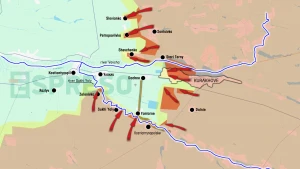
Russia may blow up ZNPP to stop Ukrainian offensive - SBU Major General Yahun
Ukraine’s Security Service (SBU) Major General believes that Russia, after blowing up Kakhovka hydroelectric power plant, may destroy Zaporizhzhia NPP to stop the Ukrainian army's offensive
He shared his opinions with Espreso TV.
"Unfortunately, Russians are mining not only Zaporizhzhia NPP, but also the Crimean Titanium plant in Armyansk, which is located on the administrative border of Ukraine with the occupied Crimea. This is also a big problem and shows that they do not care about the civilian population and their actions can lead to any kind of disaster. Russia may well resort to blowing up the nuclear power plant to stop the Ukrainian army's offensive or leave Ukraine with uninhabitable territories," Yahun explained.
The SBU Major General noted that Zaporizhzhia NPP is very difficult to destroy.
"I know that there will be no disaster at Zaporizhzhia NPP. Because it is impossible to blow up the reactor just like that. Conventional means are not capable of destroying a nuclear power plant. It would require a powerful nuclear missile. Therefore, they can cause a catastrophe similar to Fukushima, when radiation was released due to a problem with reactor cooling," he added.
IAEA response to the destruction of Kakhovka HPP
On June 6, Volodymyr Zelenskyy discussed the consequences of the Kakhovka HPP explosion and the risks for the ZNPP with the head of the IAEA and invited him to Ukraine. In response, Grossi stated that he would lead the organization's next mission to the ZNPP after the hydroelectric power plant was blown up by Russia.
Raffael Grossi later expressed concern that in two days, the ZNPP would no longer be able to receive water for cooling from the Kakhovka HPP reservoir. On June 8, the water level in the Kakhovka Reservoir dropped by 2.8 meters to 14.03 meters, and the rate of loss slowed down to 5-7 cm/h. Grossi added that if the water level falls below 12.7 meters, the Zaporizhzhia Nuclear Power Plant will no longer be able to extract water from the reservoir for the site.
On June 9, it was noted that based on preliminary conclusions from IAEA experts, the Zaporizhzhia NPP should be able to pump water from the reservoir to cool the reactors even after the level drops below the critical 12.7 meters. At the same time, Director General Grossi announced an aid program for Ukraine in response to the flooding of the dam in Nova Kakhovka.
On June 12, Grossi expressed concern about the rapid decrease in water levels at Zaporizhzhia TPP following the destruction of the Kakhovka HPP. The IAEA is requesting access to the Zaporizhzhia nuclear power plant to clarify the discrepancy in data regarding the water level at the blown-up Kakhovka dam, used for cooling the ZNPP reactors.
- News













































